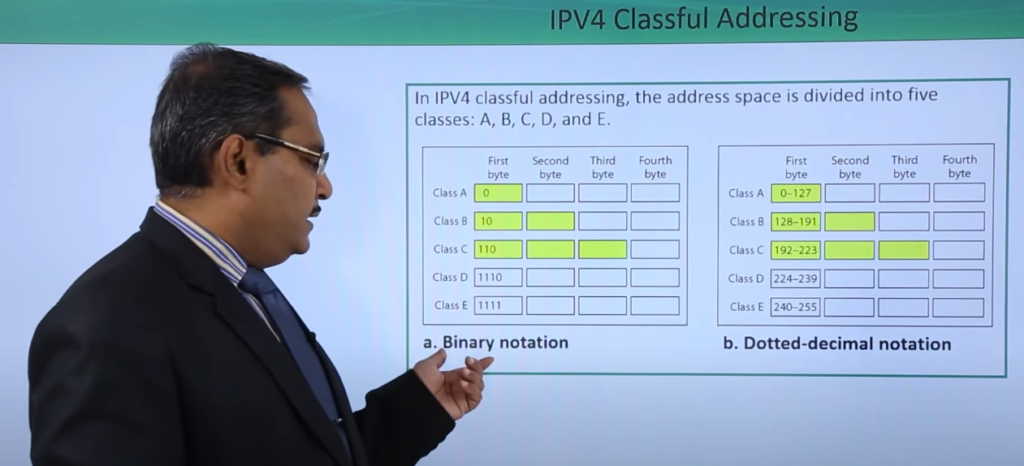When delving into the realm of computer networking, the concept of IP addressing emerges as a key foundation. The primary objective of this technology beyond mere existence, as it enables seamless interactions among devices located throughout the vast network of the internet or within their isolated local area networks. Over the course of history, there have been notable transformations in IP addressing, leading to the development of two separate paradigms: classful addressing and classless addressing. To effectively navigate the intricate landscapes of networking technologies, it is crucial to have a thorough comprehension of the nuanced differences that set apart these two methodologies. In the quest for comprehension, we will undertake an examination of the differences between class-conscious and class-blind forms of communication. This undertaking will not only elucidate the benefits and drawbacks they offer but also tackle the increasing queries that emerge in the minds of eager learners.
Classful Addressing: The Early Days

During the early development of the Internet, IP addresses were classified into five distinct groups, namely A, B, C, D, and E. Each group was assigned a proportional allocation of IP address ranges based on the size of their respective networks. Although the concept of graceful addressing initially appeared to be straightforward, its shortcomings became apparent as the internet grew in size and scope.
Classful Addressing
| Class | Leading Bits | Range of IP Addresses | Network Addresses | Host Addresses |
|---|---|---|---|---|
| A | 0 | 0.0.0.0 – 127.255.255.255 | 0.0.0.0 | 1.0.0.0 – 126.255.255.255 |
| B | 10 | 128.0.0.0 – 191.255.255.255 | 128.0.0.0 | 128.0.0.1 – 191.255.255.254 |
| C | 110 | 192.0.0.0 – 223.255.255.255 | 192.0.0.0 | 192.0.0.1 – 223.255.255.254 |
| D | 1110 | 224.0.0.0 – 239.255.255.255 | N/A | N/A |
| E | 1111 | 240.0.0.0 – 255.255.255.255 | N/A | N/A |
Although the implementation of classful addressing proved straightforward, it led to inefficiencies due to address squandering. This arose because the pre-defined address ranges failed to align with actual network requirements. For instance, a company necessitating just 1,000 IP addresses would find itself compelled to occupy an entire Class B address range, thereby needlessly depleting valuable resources.
Classless Addressing: Efficiency and Flexibility
As a response to classful addressing’s shortcomings, classless addressing was developed. Classless Inter-Domain Routing (CIDR) allowed for additional flexibility and efficiency in the IP address assignment process, making it more in line with the actual needs of networks.
Within the realm of classless addressing, IP addresses undergo a transformation into Variable Length Subnet Masks (VLSMs), bestowing administrators with heightened precision in the realm of address assignment. This intricate restructuring obviates the necessity for rigid class definitions, thereby enabling a more resourceful utilization of the available expanse of IP addresses.
Advantages of Classless Addressing
- Efficient Address Allocation: Through affording network administrators increased latitude in distributing IP addresses, classless addressing contributes to the reduction of superfluous allocations;
- Subnetting Flexibility: VLSM enables the subdivision of subnets at various levels of detail, enhancing both IP address utilization and the management of networks;
- Scalability: Classless addressing facilitates a smoother allocation of addresses as networks evolve to accommodate emerging needs;
- Conservation of IP Addresses: The capability of classless addressing to generate more compact subnets aids in the preservation of IP addresses, a particularly crucial factor given the current scarcity of IPv4 addresses.
Disadvantages of Classless Addressing
- Complexity: Owing to the necessity of furnishing subnet masks for every individual subnet, configuring and overseeing classless addressing could potentially pose greater complexity;
- Potential for Addressing Conflicts: Negligent subnetting planning can give rise to issues such as IP address conflicts and routing complications;
- Learning Curve: Individuals engaged in network administration, accustomed to employing more conventional modes of addressing, might require an adjustment period to acclimate to the novel approach and its associated terminology.
Classless Addressing Example
| Network | Subnet Mask | Usable Range of IP Addresses |
|---|---|---|
| 192.168.0.0 | 255.255.255.0 | 192.168.0.1 – 192.168.0.254 |
| 192.168.1.0 | 255.255.255.0 | 192.168.1.1 – 192.168.1.254 |
| 192.168.2.0 | 255.255.255.128 | 192.168.2.1 – 192.168.2.126 |
Conclusion
The shift from classful to classless addressing marked a momentous breakthrough within the realm of IP addressing, opening avenues for heightened and adaptable address distribution. While classful addressing showcased simplicity, the inherent flexibility of classless addressing bestowed greater efficiency in managing and using addresses across a wide array of networks. Classless addressing stands as a foundational pillar in modern networking, facilitating the fine-tuning of IP address distribution and conservation, even in the face of evolving networks aimed at fulfilling emerging requirements.
FAQ
The drawback of classful addressing lay in its ineptitude to judiciously allocate addresses. This deficiency resulted in either an abundance of IP addresses within the network, squandering valuable resources, or an insufficiency of addresses, triggering complications in subnetting.
For a more equitable dissemination of IP addresses, classless addressing employs Variable Length Subnet Masks (VLSMs) of diverse extents. As a result, we are empowered to optimize the utilization of our IP address expanse, unrestricted by artificially imposed class demarcations.
Classless addressing seamlessly integrates with existing legacy network infrastructure. Any router or device proficient in managing classful addressing can be seamlessly configured to accommodate classless addressing as well.
IP addresses along with their corresponding subnet masks can be succinctly expressed through CIDR notation. The format takes the shape of “IP_address/subnet_mask.” Employing a subnet mask of 255.255.255.0, the IP address 192.168.0.0 would be denoted as 192.168.0.0/24.
Classful addressing has largely fallen into disuse in contemporary times, owing to the strides made in networking technology. However, it might still find application within legacy systems that have yet to transition to classless addressing. Additionally, it could serve an instructional purpose within educational settings, showcasing the evolutionary trajectory of IP addresses.
